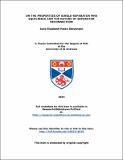On the properties of single-separator MHS equilibria and the nature of separator reconnection
Abstract
This thesis considers the properties of MHS equilibria formed through non-resistive MHD relaxation of analytical non-potential magnetic field models, which contain two null points connected by a generic separator. Four types of analytical magnetic fields are formulated, with different forms of current. The magnetic field model which has a uniform current directed along the separator, is used through the rest of this thesis to form MHS equilibria and to study reconnection.
This magnetic field, which is not force-free, embedded in a high-beta plasma, relaxes non-resistively using a 3D MHD code. The relaxation causes the field about the separator to collapse leading to a twisted current layer forming along the separator. The MHS equilibrium current layer slowly becomes stronger, longer, wider and thinner with time. Its properties, and the properties of the plasma, are found to depend on the initial parameters of the magnetic field, which control the geometry of the magnetic configuration.
Such a MHS equilibria is used in a high plasma-beta reconnection experiment. An anomalous resistivity ensures that only the central strong current in the separator current layer is dissipated. The reconnection occurs in two phases characterised by fast and slow reconnection, respectively. Waves, launched from the diffusion site, communicate the loss of force balance at the current layer and set up flows in the system. The energy transport in this system is dominated by Ohmic dissipation.
Several methods are presented which allow a low plasma-beta value to be approached in the single-separator model. One method is chosen and this model is relaxed non-resistively to form a MHS equilibrium. A twisted current layer grows along the separator, containing stronger current than in the high plasma-beta experiments, and has a local enhancement in pressure inside it. The growth rate of this current layer is similar to that found in the high plasma-beta experiments, however, the current layer becomes thinner and narrower over time.
Type
Thesis, PhD Doctor of Philosophy
Collections
Items in the St Andrews Research Repository are protected by copyright, with all rights reserved, unless otherwise indicated.

